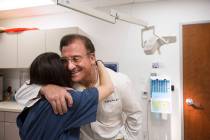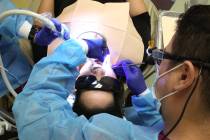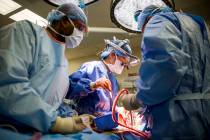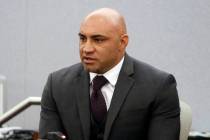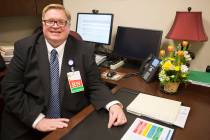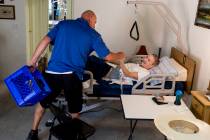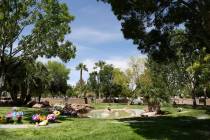A turn of events to turn the stomach
Suzanne Newton says she doesn’t normally talk much about throwing up.
She’d rather talk about her passion for flying, her husband’s achievements as an executive for a candy company or her son’s work as a Delta Air Lines pilot.
But she’s so sick to her stomach about a trip to the emergency room — it was far more costly than she ever imagined — that she feels she must talk about what sent her to the hospital in the first place.
And so soon after we greeted each other she talked ever so politely about the violent upchucking that forced her to go to the St. Rose Dominican Hospital, Siena Campus in Henderson.
“I’m sure it was the (salad) dressing I had at a buffet — it tasted funny — that made me so sick,” she said recently on a cloudless day so beautiful that even a discussion of vomit couldn’t make a stomach turn. “I was up all night throwing up and was 98 percent sure I had food poisoning.”
It was a November morning when William Newton, no relation to Sir Isaac, laid down his law and said his beloved must go to the ER. Once there, Suzanne Newton said, she was treated with compassion by everyone, “not like a number.”
Still, there was a foul-up. The nurse starting Mrs. Newton on an IV — she was in danger of dehydration — did so at first without wearing protective gloves and Mr. Newton had to remind her that to be in compliance with universal precautions she must do so. (Hospital spokeswoman Jennifer McDonnell said St. Rose nurses will now be re-educated on universal precautions.)
Be that as it may, nausea and pain medication didn’t immediately relieve Newton of her symptoms, so a doctor suggested she undergo a CT scan of her abdomen. But the 66-year-old Newton, aware that research has shown that two to three abdominal imaging tests can deliver doses of radiation in the range of exposure experienced by Hiroshima survivors in Japan, declined.
When more medication didn’t completely quiet her symptoms, the doctor again suggested a CT scan. Tired of being sick, this time she agreed to the test, which can’t diagnose food poisoning.
Soon after the test, this woman who underwent imaging tests after an auto accident felt better and was released from the hospital. She scolded herself for having the additional procedure that she fears could give her cancer.
But she didn’t get really angry about the test until her insurance company paid the hospital $10,208.49 for her treatment.
An itemized bill that she requested from the hospital showed she was charged $9,333 just for the CT scan.
Believing there had to be a mistake, she said she called several hospital officials and her insurance company. There was no mistake, she was told.
She called officials with Steinberg Diagnostic Medical Imaging Centers and they confirmed what she thought — she was charged between five and nine times what she would have paid at Steinberg’s, depending on the sophistication of the scan.
A Steinberg executive told me the same thing.
Newton is irate.
“I’m not the type who says my insurance took care of it and I only had to pay $777 out of my own pocket,” she said. “This is why insurance costs keep going up. Hospitals overcharge people with insurance to compensate for those with little or none.”
In a written statement, St. Rose officials said a comparison of CT scans is “impractical” because of “underlying cost drivers.”
Dylan Roby, of the University of California, Los Angeles Center for Health Policy Research, said what Newton believes is essentially correct. Hospitals, he said, engage in “cost shifting” to the well-insured to make up for services that don’t receive adequate payment from other patients.
“Of course, because you’re talking about a 24-hour emergency hospital with staffing, a CT scan will always cost somewhat more at a hospital,” he said.
As Roby listened to what Newton’s insurance paid for her care, he laughed and said there is no way St. Rose lost money off Newton.
“And I can guarantee you that if she didn’t have insurance, she never would have gotten that CT scan for suspected food poisoning,” he said. “The doctor would have engaged in watchful waiting.”
That isn’t what Newton wanted to hear.
“I can guarantee you I’m not happy,” she said.
Paul Harasim is the medical reporter for the Las Vegas Review-Journal. His column appears Mondays.
He can be reached at pharasim@reviewjournal.com or 702-387-2908.



